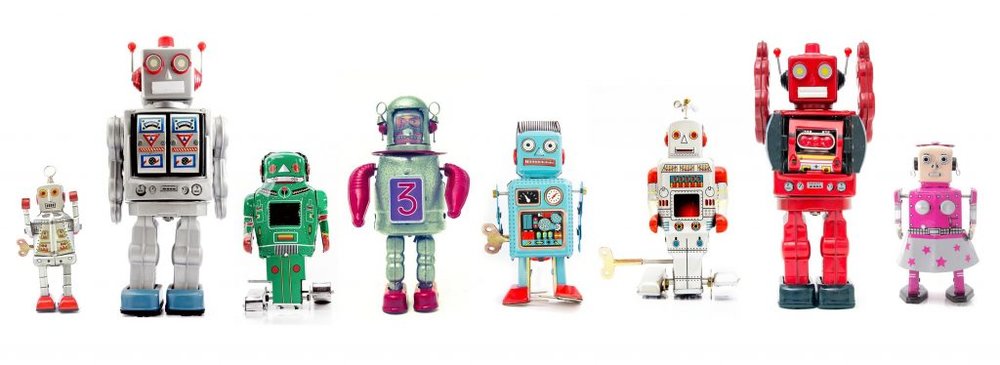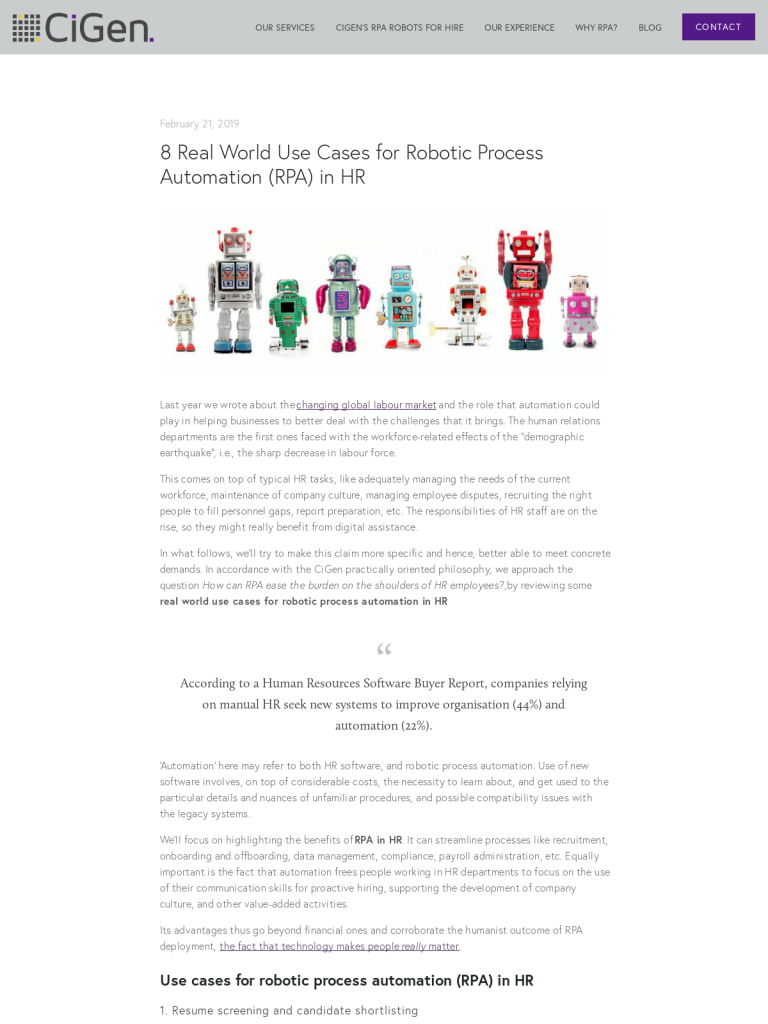8 Real World Use Cases for Robotic Process Automation (RPA) in HR
Original post from https://www.cigen.com.au/cigenblog/

Last year we wrote about the changing global labour market and the role that automation could play in helping businesses to better deal with the challenges that it brings. The human relations departments are the first ones faced with the workforce-related effects of the “demographic earthquake”, i.e., the sharp decrease in labour force.
This comes on top of typical HR tasks, like adequately managing the needs of the current workforce, maintenance of company culture, managing employee disputes, recruiting the right people to fill personnel gaps, report preparation, etc. The responsibilities of HR staff are on the rise, so they might really benefit from digital assistance.
In what follows, we’ll try to make this claim more specific and hence, better able to meet concrete demands. In accordance with the CiGen practically oriented philosophy, we approach the question How can RPA ease the burden on the shoulders of HR employees?, by reviewing some real world use cases for robotic process automation in HR.
“According to a Human Resources Software Buyer Report, companies relying on manual HR seek new systems to improve organisation (44%) and automation (22%).”
‘Automation’ here may refer to both HR software, and robotic process automation. Use of new software involves, on top of considerable costs, the necessity to learn about, and get used to the particular details and nuances of unfamiliar procedures, and possible compatibility issues with the legacy systems.
We’ll focus on highlighting the benefits of RPA in HR. It can streamline processes like recruitment, onboarding and offboarding, data management, compliance, payroll administration, etc. Equally important is the fact that automation frees people working in HR departments to focus on the use of their communication skills for proactive hiring, supporting the development of company culture, and other value-added activities.
Its advantages thus go beyond financial ones and corroborate the humanist outcome of RPA deployment, the fact that technology makes people really matter.
Use cases for robotic process automation (RPA) in HR
1. Resume screening and candidate shortlisting
Nowadays you no longer need to ask your employees to spend a lot of time going through many resumes and application forms received for open positions. Software robots can easily gather all the files and compare the information with the list of job requirements.
These requirements can be viewed as predefined rules which guide the selection procedure. The best candidates will then be notified and called for interviews, while those who don’t match the rules can be sent rejection notifications.
2. Offer letter administration
The content of offer letters must comply with different sets of regulations (company, law, etc.), and also, they must be well-tailored to the particular selected candidate. These regulations are normally stored in various systems and databases, which makes manual verification and cross-checking not only time consuming, but also prone to error.
Software robots, on the other hand, can quickly gather all the needed information, create the offer letter, send it, and eventually monitor the appropriateness of returned documents.
3. Onboarding new hires
When a new colleague joins the team, data from several systems must be coordinated in order to create a new user account, email address, access rights for applications, IT equipment, etc. Data integration capacity is necessary in order to find agreement between the employee’s profile and preferences, and typical company procedures.
With robotic process automation, the user account can automatically activate a particular template for the onboarding workflow, and this streamlines the whole process. The bots can then make rule-guided decisions as to which credentials to assign the new employee, which onboarding documents to send, etc.
RPA thus makes a significant contribution to helping new employees dive immediately into their work, find their place in the team, and feel ‘at home’ with it.
Thank you. We will be in touch shortly.
4. Travel and expense management
The manual processing might involve issues like late expense submissions, missing receipts, unclear expense justifications, etc., which negatively impact compliance as well as employees’ satisfaction. Software robots can make the process more efficient by checking individual expenses against both company regulations, and external expenditure norms.
5. Employee data management
‘Employee’ refers to current and past employees, applicants, contractors, and new hires. ‘Data’ covers company regulations, payroll and benefits. These specifications are meant to emphasize that employee data management requires orchestrated, consistent actions across several databases with different data formats.
Moreover, if you also consider the need to keep the constant flux of employee data in order, it should be easy to understand what a nightmare it is for manual performance. Robotic process automation can easily handle this, minimising the risk of incorrect data entries. By regular performance of data cleansing tasks, it ensures data compatibility across multiple databases.
6. Attendance tracking
Something like ‘learned carelessness’ might stand in the way of proper use of the absence management system by employees themselves. Size also matters at this point, in the sense that the bigger the company, the more difficult it is to accurately review time records.
Software robots can cross-check self reports against time logged in the company record, and report inconsistencies to the HR staff. They can also recommend reallocation of workforce resources when confronted with major absenteeism due to epidemics, for instance, and thereby prevent workflow disruptions.
7. Payroll management
Payroll can be viewed as a perfect example of repetitive, monotonous tasks that companies can’t do without. It typically involves large amounts of data entry, which can often lack integrity or visibility, and this ups the risk of error. Bots reduce this risk to zero, while also considerably decreasing waiting time. Avoiding delayed payments will have a positive impact on employees’ level of job satisfaction.
8. Compliance and reporting
Labour laws are among those that suffer most frequent modifications, given the need to adjust to changes in the workforce socioeconomic status, and to provide workers with adequate health, safety and welfare conditions.
Consider, for instance, the legislative development in Australia, where the Workplace Relations Act of 1996 was already replaced in 2009 by the Fair Work Act. This dynamic environment makes it rather difficult for HR representatives to adapt and prepare compliance reports. Leveraging robotic process automation in HR facilitates organisations’ adherence to constantly changing compliance regulations, and preparing accurate reports by integrating data from multiple systems.
Conclusion
RPA is not the only automation solution for HR. However, the (non-exhaustive) list of use cases for robotic process automation in HR makes it clear that it represents a feasible approach for expanding businesses. In order to become more competitive, companies will have to adapt to a growing number of employees, and to a growing amount of data and paperwork.
RPA deployment promises a more efficient data management, and consequently it streamlines rule-based HR processes. It also has good premises for improving employees’ satisfaction with their work.
We end by mentioning once again that this is part of an ongoing series of articles about real world use cases for robotic process automation in different industries (finance, retail, healthcare, etc.). If you found the information useful, please subscribe to our newsletter to make sure that you stay updated with news about the fast-evolving automation services.
Leave a Comment
You must be logged in to post a comment.








